*I'm still young, but I know my days are numbered
1234567 and so on
But a time will come when these numbers have all ended
And all I've ever seen will be forgotten
Won't you come
To my funeral when my days are done
Life's not long
And so I hope when I am finally dead and gone
That you'll gather round when I am lowered into the ground
When my coffin is sealed and I'm safely 6 feet under
Perhaps my friends will see fit then to judge me
Oh when they pause to consider all my blunders
I hope they won't be too quick to begrudge me
Won't you come
To my funeral when my days are done
Life's not long
And so I hope when I am finally dead and gone
That you'll gather round when I am lowered into the ground
If I should die before I wake up
I pray that the Lord my soul will take but
My body, my body - that's your job
Well I can't be sure where I'm headed after death
To heaven, hell, or beyond to that Great Vast
But if I can I would like to meet my Maker
There's one or two things I'd sure like to ask
Won't you come
To my funeral when my days are done
Life's not long
And so I hope when I am finally dead and gone
That you'll gather round when I am lowered into the ground*
Thanks Crash Test Dummies
We headed out at 9am in a caravan of 8 off road four wheelers. Two polar bear guards accompanied us on the journey.
Riding on the four wheelers is so much fun. Rob, my husband did a great job of driving too! We passed the infamous Barrow Whalers football field and the hunting camps. Then we made the turn onto the beach, where only select vehicles drive.
About 20 minutes later we arrived at the NuvukThe Iñupiaq name for Point Barrow and the people who lived there. Village. Laura Thomas, BASC employee who works with archeology told us a little about the area. This area contains a burial ground that in part is washing away and the rest of it has the potential to wash away. A local cultural group recruited Ann Jensen another BASC employee to head up a group and remove any artifacts or remains that they found. Anything that is found will be analyzed and moves to another ground that is less likely to erode.
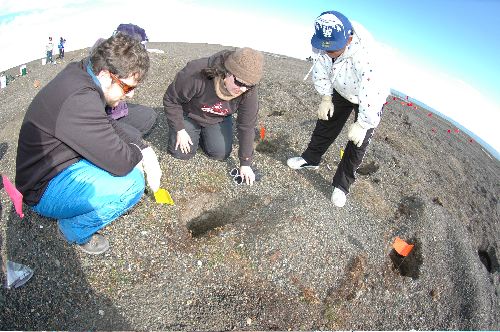
For more information, my friend Kimberly Miller from the Palm Beach Post in Florida wrote a great front-page story. I have attached it as a resource below.
Frank Kelly PolarTREC teacher is also a great resource for the NuvukThe Iñupiaq name for Point Barrow and the people who lived there. project. He arrived into Barrow a couple of days before I left. – On a side note it was great seeing him again.
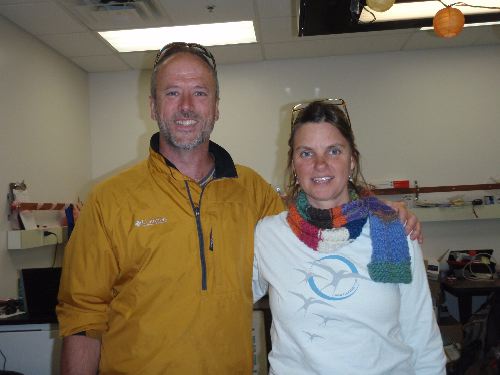
After Laura explained the project she told us that we would be digging shovel test pits. **Please note, when you dig – you really don't "DIG" you sort of toss the gravel – there is NO JUMPING ON THE SHOVEL here! Before we could get started we had to mark the area in order to know precisely where to dig. This involved measuring and placing flags marking the space to dig.
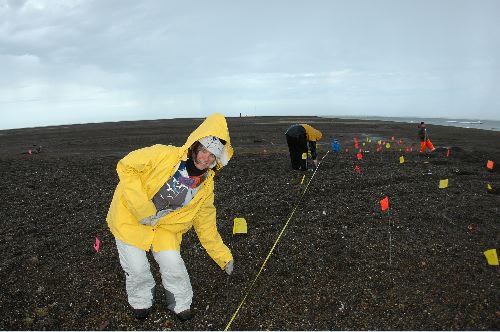
It was a beautiful day, then we noticed the clouds rolling in. It rained – hard enough for all of us to move to the tent to grab rain jackets. But the work must go on – so you work right though the rain. NO Biggie!
Laura, along with two high school workers taught us how to dig the holes, measure them and record data about the site we dug. This is very tedious work, the gravel keeps filling the hole you just dug and you have to have a hole at least 50cm.
Rob and I only had a chance to dig two holes and then it was time for lunch.
Hiroki Ikawa works just up the road east of Point Barrow Proper and he wanted us to see his project, so we took off to a more remote area with him. Hiroki is a doctoral student of University of California at Davis. He has towers set up with instruments that measure weather and levels of Carbon. His instruments are placed feet from the beach in an exact area where the wind blows in a given direction.
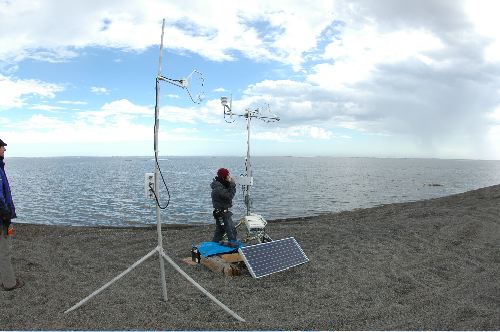
Every day Horoki drives out to Point Barrow to check on his tower to make sure things are going smoothly. If the weather gets rough Hiroki rushes out to his site to make sure that his expensive tower and instruments do not get washed into the Beaufort SeaThe Beaufort Sea lies to the north of Alaska and the Yukon and Northwest Territories..
We cruised the beaches on the four wheelers and came back to Point Barrow Proper and went to the very tip of the point, just beyond the NuvukThe Iñupiaq name for Point Barrow and the people who lived there. site. Hiroki still has a tower set up in this area as well, but he only used it last year. I tried to climb it, but when he said don't lean too much to the left or to the right because it is only anchored in sand- it freaked me out and down I came! Hiroki did climb to the top with a flag that belonged to a friend of his.
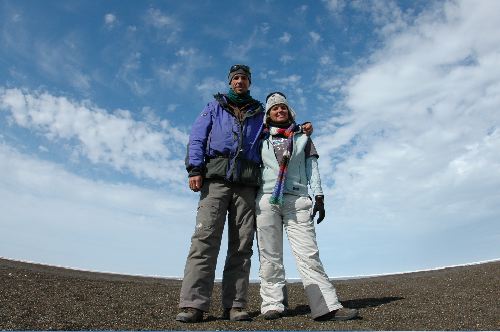
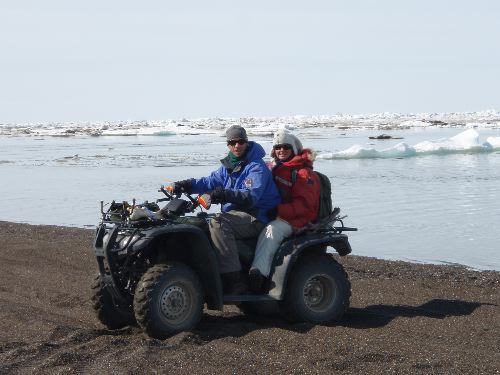
Of course we took many photos here and just beyond the tower to the very edge of North American land until it became sea floor – Awesome!
Bird of the Day
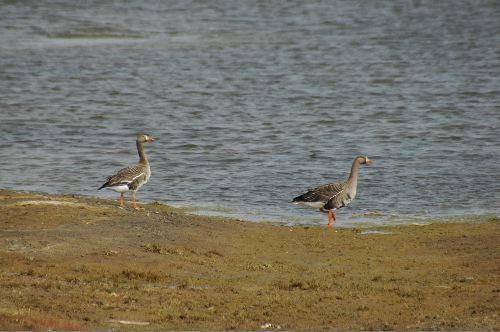
Listen to these geese http://identify.whatbird.com/obj/292/_/Greater_White-fronted_Goose.aspx
From the Top, as far as you can go on land in North America, of the World!
Where are we now on Sunday, July 13, 2008?
We made it to Fairbanks on July 12, 2008, Saturday after 10pm. I startled the cab driver because I rolled down my window and squealed the smell while fanning my hands towards the window. He almost stopped the cab and said "what's wrong – Did somebody fart?" I said NO, I smell TREES! They smelled so good too! Piney! Funny!
We stayed at a cute bed and breakfast, 7 Gables, with an amazing breakfast of Asparagus Eggs +++.
This morning we took the train from Fairbanks to Denali. It was a great morning and a great ride. The train was super nice with large windows and areas that are called Domes because the windows are domed around for panoramic view!
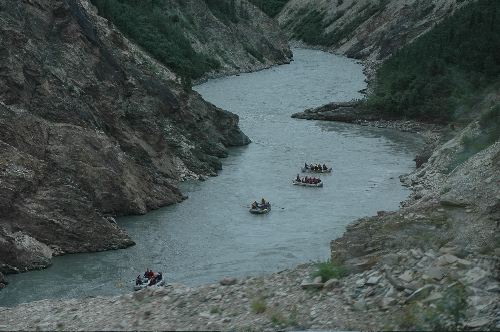
We are staying at Denali River Cabins. Shortly after we arrived we took a wonderful sauna break, took a nap and I realized that I am exhausted! I could sleep for days.
But I didn't – we got up and went to town we were ate the Salmon Bake. We had a great meal and headed back to walk along the Nenana River and they hit the sack!

**=== From just below the top of the world! **
| Attachment | Size |
|---|---|
| Scientists race to rescue cemetery from ocean.doc33 KB | 33 KB |


Comments